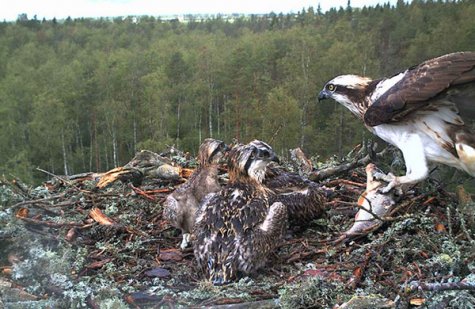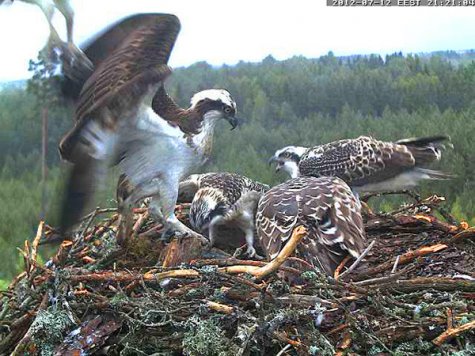Osprey cameras remain interesting to follow
Text: Urmas Sellis (ESTLAT Eagles coordinator in Estonia)
Web camera image: Fleur (from LK Forum)
Web camera image: Fleur (from LK Forum)
The Osprey web cameras of the ESTLAT Eagles cross borders project are popular around the world, with about 2000-3000 simultaneous watchers almost every daylight time. It has been possible to see nest life from renovation of the nest in spring and up to fledging of chicks. The Ospreys in the Latvian nest were extremely early breeders and all chicks are fledged by now. So sometimes, and soon more often, we can see the nest empty already...
True, the first and unexpected flight from nest was caused by the ringing team, but it ended successfully (not counting one unringed chick, whom we can't recognise in the future).
The nestlings in the Estonian nest are nearly one month later in development. There it is still possible to see many fish flying into the nest within the next weeks through the camera stream.

The Estonian Ospreys are not so talkative when consuming fish, yet.
The chicks in the Estonian nest we will try to ring early rather than late. Quicker action is needed too because of some dirt on the camera lens cover; we want to clean it.
Most probably the fledged chicks in the Latvian nest will be visible during another month, but maybe the female parent will leave on migration quite soon. Then the juveniles must feed by themselves from the fish brought by the male. Distribution of food involves a lot of noise and it will be the same in the Estonian nest at the same breeding stage.
There is a plan to tag two Ospreys in both countries with transmitters during the next few weeks. We could then follow their migration southwards. If this is possible to do with our camera nest friends we don’t know yet.
In Estonia we have tagged two juvenile White-tailed Eagles with transmitters as well, but those are still mainly near their home nests, so we can't show their movements yet. In Latvia we plan to equip two adult White-tailed Eagles with transmitters, nevertheless that is not an easy task... In early spring both project teams spent a couple of weeks trying to trap adults, unfortunately not successfully.









